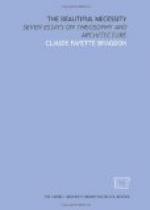Music depends primarily upon the equal and regular division of time into beats, and of these beats into measures. Over this soundless and invisible warp is woven an infinitely various melodic pattern, made up of tones of different pitch and duration arithmetically related and combined according to the laws of harmony. Architecture, correspondingly, implies the rhythmical division of space, and obedience to laws numerical and geometrical. A certain identity therefore exists between simple harmony in music, and simple proportion in architecture. By translating the consonant tone-intervals into number, the common denominator, as it were, of both arts, it is possible to give these intervals a spatial, and hence an architectural, expression. Such expression, considered as proportion only and divorced from ornament, will prove pleasing to the eye in the same way that its correlative is pleasing to the ear, because in either case it is not alone the special organ of sense which is gratified, but the inner Self, in which all senses are one. Containing within itself the mystery of number, it thrills responsive to every audible or visible presentment of that mystery.
[Illustration 87]
If a vibrating string yielding a certain musical note be stopped in its center, that is, divided by half, it will then sound the octave of that note. The numerical ratio which expresses the interval of the octave is therefore 1:2. If one-third instead of one-half of the string be stopped, and the remaining two-thirds struck, it will yield the musical fifth of the original note, which thus corresponds to the ratio 2:3. The length represented by 3:4 yields the fourth; 4:5 the major third; and 5:6 the minor third. These comprise the principal consonant intervals within the range of one octave. The ratios of inverted intervals, so called, are found by doubling the smaller number of the original interval as given above: 2:3, the fifth, gives 3:4, the fourth; 4:5, the major third, gives 5:8, the minor sixth; 5:6, the minor third, gives 6:10, or 3:5, the major sixth.
[Illustration 88: ARCHITECTURE AS HARMONY]
Of these various consonant intervals the octave, fifth, and major third are the most important, in the sense of being the most perfect, and they are expressed by numbers of the smallest quantity, an odd number and an even. It will be noted that all the intervals above given are expressed by the numbers 1, 2, 3, 4, 5 and 6, except the minor sixth (5:8), and this is the most imperfect of all consonant intervals. The sub-minor seventh, expressed by the ratio 4:7 though included among the dissonances, forms, according to Helmholtz, a more perfect consonance with the tonic than does the minor sixth.




